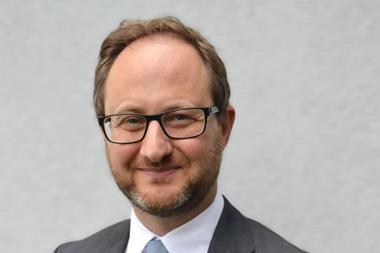German investment managers are seeing increasing demand for risk management services, including high reporting standards. And this has heightened in the wake of the credit crunch. Barbara Ottawa asked asset managers for their views on current thinking and on the outlook and trends in institutional business
Continuing professionalisation of German institutional investment is leading to an increased demand for risk management, especially in the current market environment in which liquidity, security and transparency of investments is most important for many investors.
However, not all investors will outsource this responsibility says Bernhard Kraus, managing director at Union Investment Institutional (pictured left). “There will be two groups of investors in future, those that will pass on decisions concerning asset management and risk management to investment houses which offer packaged solutions, and those that will try to do risk management themselves,” he says.
“Risk management is a very important topic, not only because of the recent turbulence on capital markets but because of changes to the insurance supervision,” notes Georg Thurnes, a board member at consultancy BodeHewitt. “The changes include a stronger focus on risk management and the compilation of a risk manual which made funds go through their investments with a fine-tooth comb. In combination with the global capital market developments everything with a bit of risk attached to it is now subject to careful analysis under risk management perspectives.”
This also puts asset managers under pressure to provide additional services. “Investors appreciate special reports and scenario analysis on top of the normal reporting,” says Kraus. “In two to three years this will be part of standard reporting and such services have already become a deciding factor in awarding mandates. Asset managers will have to check whether they have enough resources in-house to offer these additional services or they have to look for a partner in this field.”
He adds: “As investors are getting more anxious to have full transparency in their investments and also want to know what risks they are paying for the demand
for pure alpha increases.” This is another challenge for many asset managers. “Some transfer alpha generated from a successful equity product onto a bond structure and sell it as a successful fixed income product with alpha. But things do not work that way. Institutional investors want pure portable alpha where the source asset class is clearly defined.”
Similarly, hedge fund managers will come under close inspection, says Olaf John, head od distribution for Germany and Austria for Lehman Brothers Asset Management. “We expect increasing demand for fund of hedge fund products as people are going out of equities and into hedge funds. But it has become more difficult to find the pure alpha funds that many investors are looking for. A number of fund of hedge funds have beta-related market risk.”
Thurnes sees less demand for hedge funds. “There is a trend towards increasing interest in hedge funds as investors are looking for uncorrelated investments but it is certainly no mass exodus.”
“This trend towards more alternatives has to be seen over the long-term,” says Rainer Beutler, head of global institutional accounts at Pioneer in Munich. “At the moment fear dominates most investment decisions and there are only a few who dare to enter new investment areas at the moment with others only following very slowly. We currently see a very attractive market environment - also for hedge funds. You would have to go far back in time to find similarly low valuations, which provide investment opportunities. But we accept that investors are a little confused and need time to understand what is happening.”
“There is a lot of confusion among German institutional investors, particularly pension providers, as they had not been immediately affected by the sub-prime crisis but are now feeling the after effects,” says Hartmut Leser, head of Aberdeen Asset Management in Germany. “So they do not dare go into equities, low-risk bonds are at a high price level and credit products are seen as being still too risky.”
Kraus notes the markets are currently “still in a phase where financial corporations are publishing their quarterly results and further bad news might emerge. But from the middle of the year we see good opportunities in corporate bonds including the financial sector. As regards high yield, we are watching the field but not investing yet.”
New opportunities in the fixed income sector will be one of the investment trends for 2008 with one reason being “the increased risk management which led many to check critically whether they do understand the structured products they have taken on board in the fixed-income sector when yields were low over the last years”, says Thurnes.
Diversification of portfolios also frequently means regional diversification and Beutler notes that while in the past institutional investors in Germany had a very strong home bias, most have now realised international diversification is necessary: “Both in their bond and their equity exposure they are increasingly looking at emerging markets, which can mean quite different regions according to the client’s wishes. In the fixed-income sector it is mostly Asia and Latin America while on the equity side it is these two areas plus eastern and south-eastern Europe.”
However, Thurnes sees a caution among investors towards non-European investments: “The further away from Europe the less investors are interested as they want to keep [to] what they understand,” he says.
For those that take a more global view this change in orientation often leads away from benchmark-oriented thinking. “Investors have started to realise that global secular trends like the rise of a middle class in Asia, demand for infrastructure, development of emerging and demographic changes cannot be reproduced by standard indices,” Georg Schuh, CIO at DB Advisors adds (pictured right).
He anticipates that there will be a more pronounced split between benchmark-reproducing and active manager mandates. “The classic mandates against a benchmark like the EuroStoxx50 is already very much cannibalised by ETFs. In a few years these mandates will be even more covered by ETFs, not necessarily because they are that much cheaper but because consultants are pushing that way and because in efficient markets like the one covered by the S&P500 it is difficult to adhere to the tight tracking errors of around 2% that some institutionals are demanding.”
Secular trends like environmental changes and food distribution have contributed to a focus on sustainable investments which “will continue to influence capital markets in 2008 once the turbulence has died down a bit”, says Beutler. “The question of sustainable resources is of course to a certain extent also linked to the demand for commodities. And while some of it is just a fashion trend several products offer good returns.”
Kraus confirms his company is seeing growth in individual environmental, social and governance (ESG) mandates as the media devotes more space to governance issues. “Companies have noticed that having good governance as well as environmental and social standards in place is not just a question of image but also an economic factor,” he says.
However, he is cautious about some of the special investment themes. “The problem with some of these fashion trends, like timber equities, is that when more people are investing, a large asset volume hits a very small investment area leading in turn to a distortion of valuations.”
In the current market environment Schuh also issues a word of caution when it comes to funds with an environmental, social and governance theme: “We are underweight equities and are cautious about correlated products including some ESG-themed funds which have a low tracking error to traditional indices. We are in a bear market and there is uncertainty how big the influence will be. There is a high probability that the banking crisis will have a negative effect on the real economy - particularly in emerging markets.”
He adds: “It is quite a different matter with really alternative investments, which are rare and where only small sums can be invested only over a longer period such as in soft commodities. For example, in the timber market we might be at the beginning of a hype and those that invested first will profit. The theme of dwindling resources and the question of distribution of food is a secular trend where you can invest outside, regardless of short-term market trends.”
Participating in these investment opportunities should now be easier for pension providers in Germany. Under new insurance regulations, the so-called Anlageverordnung, Pensionskassen are now allowed to invest in commodities directly.
However, Oliver Roll, head of Threadneedle’s German operation, notes that the regulator now demands commodity investments to be counted among the 5% hedge fund exposure, which could deter some investors since the allocation might be too small to create diversification.
German investors mistrust self-proclaimed panaceas like absolute return products, says Leser. “There is scepticism among German institutional investors vis-à-vis promises of absolute return.”
“The euphoria we saw for these products after the burst of the internet bubble has been dampened by the realisation that after fees the real return was more or less zero,” says Roll. However, he adds that there is a trend towards more absolute return thinking away from benchmarks - not through products but via more diversification in the portfolio.
“The trend towards absolute return thinking is definitely ongoing but it also depends heavily on market cycles,” says Schuh. “In a bull market most investors are content with equity performance but as soon as the markets turn they want an absolute return rather than one relative to a benchmark.”
Leser says absolute return approaches are inherent in the system of German pension providers as “many have a target return which they have to achieve each year no matter how the benchmark performs”. He also says the use of plain vanilla bonds, such as Namens-schuldverschreibungen, is in itself an absolute return approach as these 10 year illiquid assets keep their value in all markets. “That is another reason why there was never much need for absolute return products.”
“Most of these products are quite opaque and therefore not very interesting for investors, so they are rather trying to achieve absolute returns themselves through more diversification,” says Dirk Söhnholz, managing director of Feri Institutional Advisors. “However, investors are hindered in that by regulatory restrictions. Unfortunately, the German regulator is looking more at the single risk of certain asset classes rather than the overall risk in the asset allocation.”
And Roll does not think this situation will change soon. “After this financial crisis more regulation is under consideration and there is a persistent belief that regulation will solve the problem. However, the truth is quite to the contrary. Many investors, like regional banks, had to search for return in credit spread products as they were restricted in, for example, hedge fund investors, and then they were hit by the sub-prime crisis. If the regulator bans more asset classes investors will find new products and this will prompt the inventiveness of providers.”
Overall there will be a shift towards adoption of further trends, including diversification. Leser believes many boards are undergoing a generation change. “As people at the top are becoming more educated they are also demanding more from their asset managers and are starting to question the use of, for example, the house bank’s products. Germany will develop away from relationship based market to a performance driven one in which financial services providers that only offer asset management on the sideline will find it harder to get
clients.”
Fiduciary management
The master KAG brought German institutions an invaluable means for the consolidation of investments within one reporting framework. And increasingly, risk management, asset allocation decisions and other associated services have been outsourced to master KAGs.
Could the next step be a market for full fiduciary management, as seen in Holland? This is the question that a number of asset managers have asked recently, particularly given the rise and rise of the fiduciary concept over the border in the Netherlands. This interest was particularly awakened by Henkel’s award of a fiduciary mandate to Goldman Sachs Asset Management last year. However, the answers range from the moderately enthusiastic to the outright secptial.
“Over the last years the administration side has become too much for some and the number of managers has grown enormously bringing with it an endless number of meetings to attend and reports to read,” says Schuh.
“Fiduciary management has started a trend. It is a small bud which might develop and asset managers are offering it. You could also call it a one-stop-shop as clients want less to do with asset management decisions.”
Leser says the tide may be changing. “It seems corporates are beginning to show more interest in the fiduciary route and large German banks will see the demand and start to offer it,” he says.
Stephen Bayly at BlackRock, (pictured left) agrees: “Holland will be the proving ground for fiduciary management. If the system should prove itself in Holland, some German institutions may follow.
“Investments, reporting and risk management are becoming more complex and investors are talking about fiduciary management and are trying to establish whether it might be a more feasible way to simplify the approach.”
So far, few investors have opted to hand over investment decisions altogether, be that to an asset manager, a fiduciary manager or their master KAG. And clearly, the concept would fit more naturally within corporate pension funds, which in any case usually come under the auspices of the sponsor’s chief financial officer.
A corporate finance department generally sees pension issues as peripheral, so one-stop solutions look more attractive. Conversely, there is no particular reason to imagine that sector or company Pensionskassen, would want to put their own in-house investment team out of business - at least for now.
For some, perhaps, the memory of house bank relationships - where the investment divisions of corporate finance providers also often ran pension assets - may be too fresh in the mind. And the move to multi specialist management approach arguably took longer to take hold in Germany.
“Large corporates have only quite recently separated themselves from their house banks,” says Bayly. “They are moving towards a more consultant-driven approach as in the Netherlands where consultants are running the searches [but] it is early days for fiduciary management in Germany.”
John notes that German investors were fairly late to use investment consultants: “It may take a bit longer than, for example, in the Netherlands for investors to start outsourcing these kind of decisions.”
Others are outright sceptical: “We see little demand for fiduciary management as we know it from the Netherlands, which means the complete outsourcing of all asset management services including ALM studies, strategic asset allocation, manager selection, management and monitoring,” says Söhnholz, which offers fiduciary advice, also known as implemented consulting, in Germany and abroad. “So far some Dutch funds have not had the best experience with fiduciary management. They were often disappointed both with the performance and the service offered.”
Roll is worried that outsourcing could lead to a few providers dominating the market - back almost to the old balanced, house bank approach. “German institutional investors are very professional, they are using professional consultants and there will always be the temptation to outsource decisions but I do not say fiduciary management really catching on.”
“Many investors do not want to be dependent on one single financial service provider,” adds Söhnholz. “Feri’s research has confirmed that for many large investors it is better and cheaper to leave much of passive asset management in-house and use more than one outside provider for other services.”












No comments yet